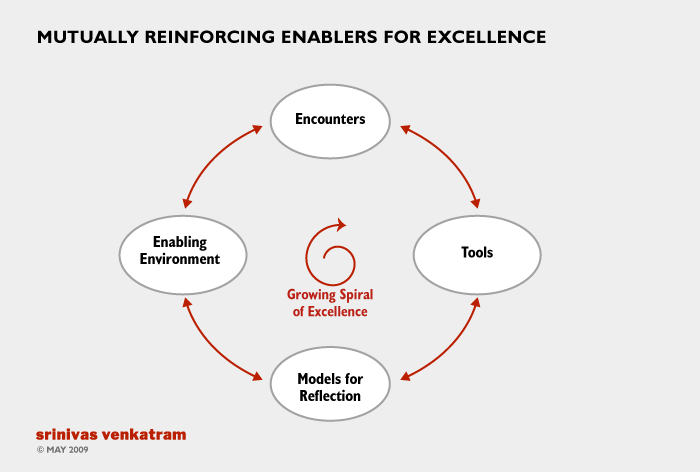I
In almost every community we have worked with or visited, there has been one common problem, one theme, that has run through all developmental efforts. The problem of excellence. A company seeks to introduce Quality Programs, people ask why. A leader wants her team to learn more and adapt to new technologies, people silently resist it. A government seeks to lay out an exciting vision of global leadership, people (in their minds!) wonder if it is possible.
II
In other words, people are finding it difficult to relate abstract ‘good ideas’ like excellence, quality, faith, growth, achievement with the day-to-day personal and professional concerns that constitute their lives.
III
On deeper thought, it can be seen that the same issues underlie the problems faced by three distinct groups of people (i) those who are seeking to build superior institutions, (ii) those who are seeking to compete better, or (iii) those who are simply trying to question and challenge the status quo in their individual areas of endeavour.
IV
What is the bridge between excellence and one’s own life? It appears that the bridge cannot be “external motivation” but is “internal motivation”.
V
Put another way, one becomes excellent because one chooses to be excellent. When one chooses to be excellent, the result is an interest in all things associated with excellence.
VI
When do individuals choose excellence in their lives? When they see the relationship between quality of output and significance of life, when they recognize the meaning of performance, and when they come to recognize that learning and growing is an end in itself.
VII
What then is the “trigger” that enables individuals to embark as this cycle of growth and excellence?
VIII
The trigger appears to be an encounter with quality: when individuals come face to face with people or situations or events where the value of great performance, of raw professional competence, of true meaningful effort, becomes obvious to them. This encounter could be with role models or aspirational figures, with people who are known to have excelled, or even with powerful books or films. The important thing is the encounter.
But the encounter is not enough.
IX
What is also needed is reflection, (the availability of conceptual models and frameworks of learning that allow these encounters to be truly assimilated)
X
Equally important is the necessity of practice. The opportunity to test and refine ones own understanding withinn the warp and weft of real world action. Put another way, there must be at least one or more “zone of excellence” in one’s life where one is willing to make the choices and sacrifices needed to encounter and realize excellence.
XI
Finally, what is also needed is a group of people who are willing to provide the moorings for the emotional and self-esteem related changes that such a journey involves – the enabling environment.
XII
Putting these four elements together – the encounters, the tools and models for reflection, the opportunities for translating these ideas into action, and the enabling environment of role-models – constitutes the ingredients of excellence in human systems.

XIII
Most important, these four elements – the presence of encounters, the opportunities and models for reflection, the availability of “zone of excellence” and the presence of an enabling psycho-social environment – are seen to be mutually reinforcing if we seek sustainable interest in human excellence from ourselves and our people.